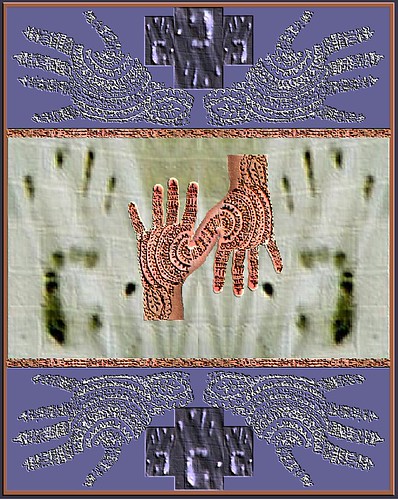Point-Counterpoint

I originally created this image (using MS Paint and MS Photo Editor) for Flickr's Manipulate This! group. To Hashim A's "Mehndi III" I've added my "Handprint."
After the fact, I realized that the following entry would probably fit the "Left & Right" prompt for this week's Sunday Scribblings...
I've got two major "courtroom drama type" scenes planned for Book #6 and am about to embark on the first one. Before the actual drafting begins, I've been doing my version of outlining, which here consists of constructing a "To Do" list of everything I want that scene to accomplish. I've got:
1. The two Big Issues of the book, which together form the underlying main conflict because they are intimately related and they polarize the characters. They form the heart of the "courtroom" debates. One in particular will drive this first debate.
2. The motives of everyone in the room, as seen through the eyes of the POV (point of view) character for that chapter. That's where the Big Issues become personal, so that I'm not left with a bunch of talking heads. Among the characters in attendance, two are leads, two are strong minor characters, and the remaining four are my equivalent of a Greek chorus, there to provide world-building information and to underscore the motives.
One character is trying to rewrite history and would like nothing better than to kill the one whose worldview threatens her legacy. Two (including the POV character, whose loyalties are divided) are trying to change a paradigm. Two, who right now possess differing opinions, will become lovers when one goes to the other for refuge.
The risks: species extinction and environmental destruction, about which the principles are in disagreement in the big picture; and tragedy and trauma versus triumph on the personal end.
This book is a challenge to write on several levels. Translating the political into the personal means I'm whittling the Big Issues down to the gut level, to lend the characters emotional authenticity. I have to get into their hearts so that I know what drives them. Since this is the sixth book in the series, their histories and hearts now possess established precedents from which I can draw. The narrative voices belong to the younger and now adult generation, which lets them provide some recap from a different perspective.
This is also a first-person-narrative book in an otherwise third-person-narrative series, which means I must treat the voices themselves in a different way than before. I must tighten my focus on each. Each voice possesses its unique style of speaking and of perception, so it's a case of not only what information the character gives, but of how he or she gives it. That was true in the third person, but it's even more pronounced in the first person.
My visual analogy (subject to interpretive debate, I'm sure) would be Seurat versus Warhol. Seurat's "third-person" painting presents different characters and objects, each with its individual style but all presented within a pointillistic context: a single underlying and overarching visual narrative:

Georges Seurat, A Sunday on La Grande Jatte, 1884
In contrast, Warhol repeats his portrait of Marilyn Monroe using different and individual color combinations. "First-person" perspectives on the same subject relate to each other but possess their own microcosms of visual rules:

Andy Warhol, Marilyn Monroe, 1967
(Both images come from Sweet Briar College student Maria Lacy Kitchin's paper, "Art and Expression," art history senior seminar, Spring 2004.)
Trust me, I didn't set out to write a story and go, "Let's see how hard I can make this on myself!" This is what my Muse is demanding of me right now. Sometimes she just leads me by the hand through a magical wood and all I have to do is type away and go Oooooh! Some of the chapters are like that, thank goodness: straightforward and simple and a helluva fun ride. But right now my Muse is a drill sergeant: You say you've never done chin-ups before? Well, start training, bucko!
Oof.
So I scribble in my journal, working on the scene's foundation and on ways to translate ideas into dialogue and emotion, using the available props and planting little seeds of foreshadowing. On a canvas, this would be called the underpainting. If I do my job right, my overlying colors will stand out and won't turn my picture into mud.
 | Deviations: Covenant can be pre-ordered from Aisling Press and also can be ordered from AbeBooks, Amazon, Barnes and Noble, Powell's Books, and Target. The Deviations page has additional details. |











2 Comments:
Great work.
Interesting post! Your book sounds challenging and extremely readable!
Post a Comment
<< Home